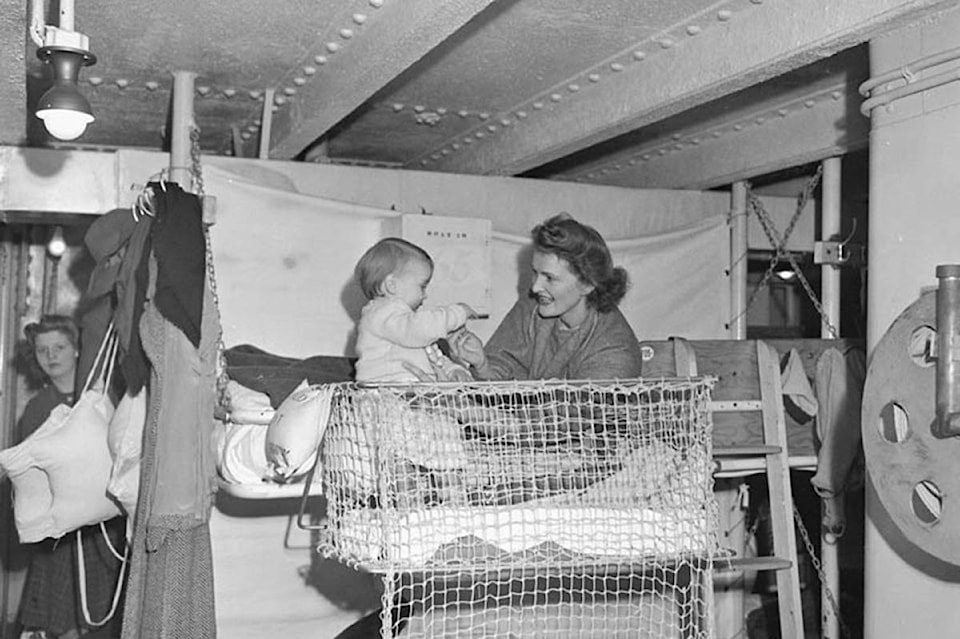By Sue Bryant,
Cloverdale Reporter
During the Second World War, more than 48,000 women and 22,000 children made their way to Canada from the war-torn battlefields overseas.
The majority emigrated from Great Britain and Holland, but some came from other areas of Western Europe, as well as Asia. While the First World War had also seen its share of war brides, it was the mass emigration of women travelling alone or with young children following the Second World War that solidified what we know now as the war bride story.
Surrey welcomed several hundred of these newcomers to Canada. One needs only to read the newspapers from 1944 onwards to see the columns filled with names of women who followed their husbands, who they may have only met once or twice before emigrating, and found their way to the quieter, more rural life in the Lower Mainland.
These women had been through the horrors of war in their hometowns. They had very little knowledge of what a life in Canada would be like, but often felt it was worth taking the leap of faith to join the Canadian servicemen they’d fallen in love with.
This was before air travel was the norm and the journey overseas was daunting. The war bride ships, such as the RMS Aquitania and the HMS Queen Mary, were retrofitted to hold large numbers of women and children. Often, one room would hold twelve bunk beds and each woman would be assigned one bunk for her and any children she was travelling with. It was not uncommon for the women to be pregnant as well, adding to the challenges of long distance travel.
For the British war brides, the common leaving point was Liverpool. The ship would travel in a zigzag formation, escorted by military minesweepers. The trip across the Atlantic Ocean could take as little as four days or as many as ten. In the early days of the war bride ship arrivals in Halifax at Pier 21, the military bands would often play “Here Comes the Bride” to welcome the oft-seasick and weary travellers. As the numbers of incoming ships increased, this happened less and less.
Those destined for Surrey still had another week’s journey by train before they arrived at their new home. The vastness of Canada became apparent to many of the women as they travelled. England alone could fit four times over in British Columbia. Once arriving in the smaller communities of Cloverdale, Clayton, Crescent Beach or Tynehead, many felt overwhelmed by rural landscape. It was a far cry from the busy, developed areas of Britain and Europe.
In November 1944, MLA Dorothy G. Steeves, one of British Columbia’s first female politicians, visited Cloverdale and gave a riveting speech announcing the arrival of war brides to the local area. A war bride herself, Steeves had emigrated from Amsterdam following the First World War. According to the Surrey Leader, Steeves said that “the high hopes and boom, the depression and return to war was a cycle that could be repeated again unless women took a more vigorous, intelligent part in the wider world outside their doors.”
By 1945, several hundred British brides had already arrived in Surrey and many local organizations worked tirelessly to welcome them to the area. The White Rock Red Cross, the Cloverdale Women’s Auxiliary and the Fleetwood Troop Aid took leading roles in organizing the “Welcome Home” committees. Often, a gift of a decorated wheelbarrow or a wagon was given as a gift. War rationing was still in place and gifts tended to be of a more practical nature. “Stork Showers” were also held for the new mothers, as the community took on the role of family providing for the new babies with hand-knit and clothing to welcome the “wee ones.”
One such story is that of Alma Savage. Alma was working in a munitions factory in Nottingham, England, when she met her husband Frank, a naval officer.
They were married and applied for approval for Alma to emigrate to Canada. She arrived in 1945 through Halifax’s Pier 21, pregnant and accompanied by her toddler son. Her husband joined her in Ocean Park once his service had completed, and they lived there for more than three decades while raising their family.
Alma had a passion for volunteering and served in several capacities of the the Ladies’ Auxiliary of the Crescent Legion Branch 240, including in the role of President. Her lifelong commitment to community left an indelible mark on all that knew her before she passed in 2013 just shy of her 93rd birthday.
These women have been often referred to as the “last pioneers.” They took a chance on love and a chance on a new life without knowing where it would take them. They became leaders of their community and changed many a life through their fortitude and spirit.
Sue Bryant is an oral historian and a member of the Surrey Historical Society. She is also a digital photo restoration artist, genealogist and volunteers at the Surrey Museum and Surrey Archives.
